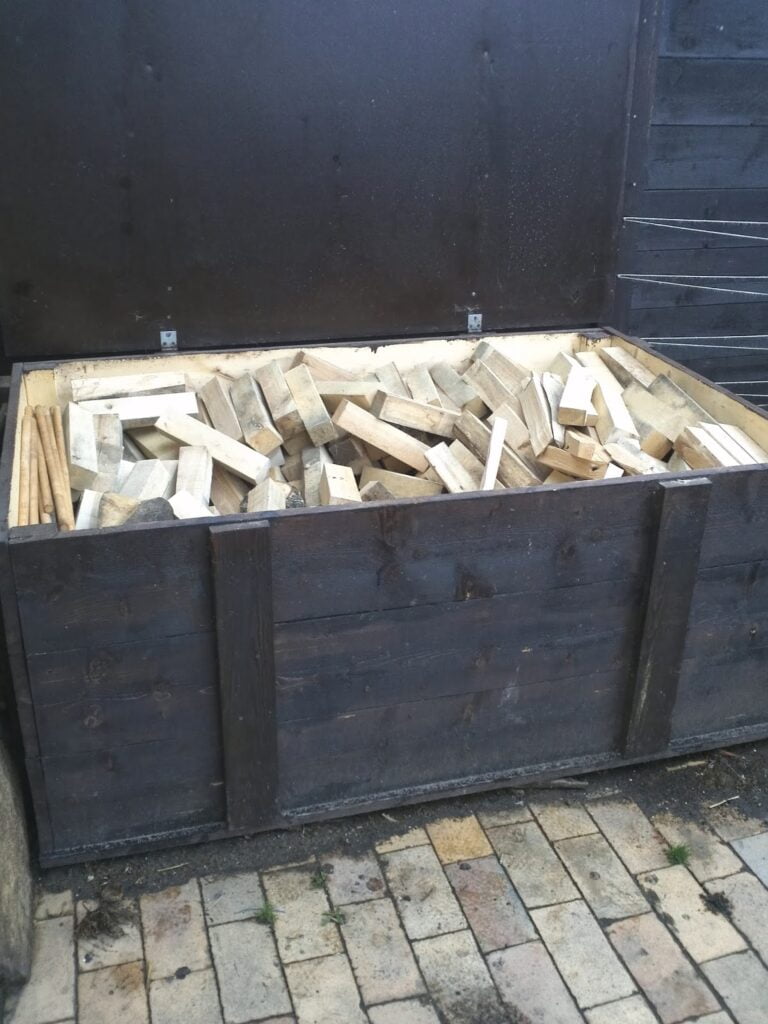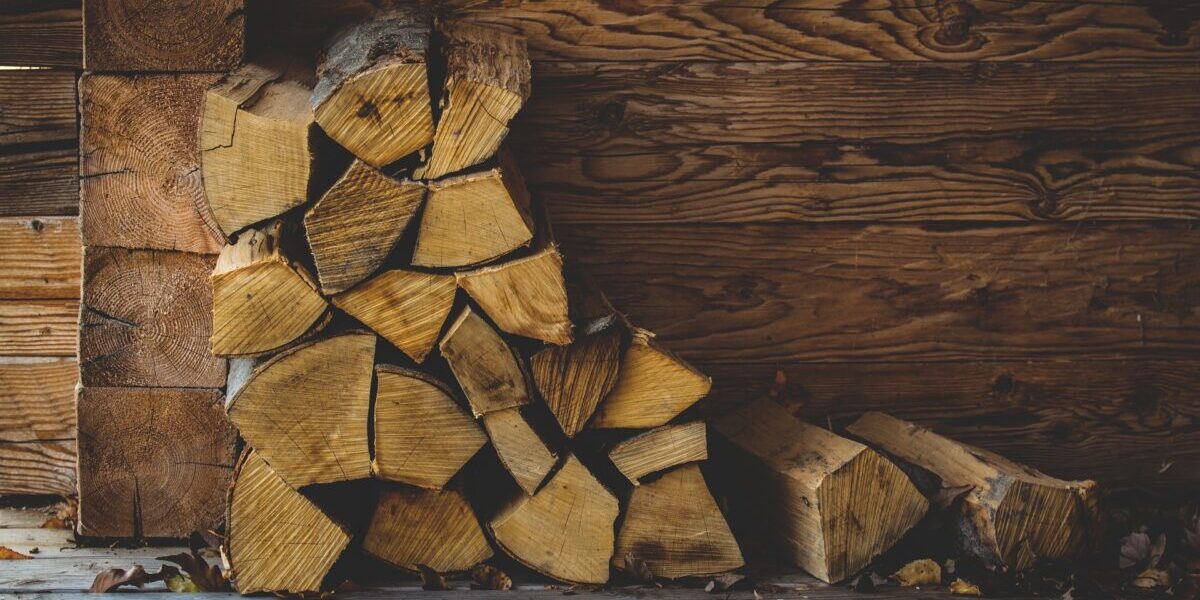Storing firewood is a big part of preparing firewood for the winter. Once the firewood has been cut it is critical to select an appropriate storage method in order to safeguard all your hard labor and money spent. After spending a lot of time chopping and cutting, the last thing you would want to do is throw it in a pile and simply hope it survives the winter. The elements can be harsh, and wood is especially vulnerable to weather conditions such as rain and snow.
Inadequate wood storage could result in firewood that is damp, unseasoned, and vulnerable to decay and mold. A large pile of wood also appeals to a variety of animals and insects looking for a place to hide and nest, which is something you would want to avoid.
It is good to store the firewood in a well-ventilated firewood shed. It is also important to have air between the logs for faster drying, so how you stack the logs matter. You don’t have to store the firewood in a wood shed, however, but it is available on most farms and is usually the first choice when it comes to storing firewood. We’ll go through the different methods and their pros and cons below.
Table of Contents
Storing Firewood – where to start
When it comes to storing firewood, one of the most essential things to master is proper stacking technique, which will ensure that the wood dries out as quickly as is humanly possible. A haphazard pile of firewood in the middle of your yard won’t last nearly as long as wood that has been stacked in the correct manner. There are many effective strategies for stacking, but there are also some ineffective strategies that you should avoid.

Methods to store Firewood and to best keep it dry – Best place to store firewood
When looking for a place to store your firewood, you should consider the situation over the long term. You will probably utilize the same space again the following year, as well as the season after that. Therefore, make sure that you get it right the very first time. You should position it so that it is in close proximity to your house or wood stove, but perhaps not right in the front yard. You should also give some thought to how the firewood will be brought inside during the winter months.
Storing Firewood on Pallets
Wooden pallets make the ideal floor for storing firewood and are usually cheap and simple to come by. If you have some old pallets lying around they make the ideal floor for storing firewood. They function incredibly well because they produce a level base for you to stack the wood on. They also enable airflow around the wood and raises the wood from direct contact with the ground. Combined with a tarp, pallets make an excellent starting point for storing firewood. Pallets are also excellent for constructing the floor of a firewood shed.
Firewood tarps and coverings

Firewood coverings come in a variety of different types. Simply covering your firewood with a blue tarp and staking or tying it down on the corners is one of the most commonly used methods. It is also possible to cover your firewood stack with scrap plywood, tin roofing and other materials to keep rain and snow off of it.
No matter which choice you select, keep in mind that you should only cover the top third of the firewood stack. If you cover the entire stack, there is considerable likelihood that the firewood will grow mold. This is since the moisture inside the wood is unable to escape if completely covered. If the sides are left exposed the moisture will dry out from the sun and wind.
Stacking the wood along a wall
At least three feet should separate firewood racks from a house, but five feet is preferable. If you store wood too close to your house, pests might find their way inside. A plate should be placed on top of the wood to protect it from the elements and allow for some air space between the wood and the wall.
In general, it is a good idea to try to steer clear of damp areas and surfaces.
A slope or sink where water might collect is not a good place to stack the wood.
Build a Firewood Storage Shed
Utilizing a firewood storage shed is, without a doubt, my number one choice when it comes to ensuring that my firewood remains dry. There are many excellent ways to create a shed that will fit precisely on your land and will last for many years; however, the costs associated with these options are significantly higher than the cost of a blue tarp. The shed will guard the firewood throughout the season in which it is drying, ensuring that it is in good condition when the colder months arrive.

A great environment for storing firewood is created by using slatted sides that allow wind to enter the stack from all directions, a steel roof to shed rain and snow, and an elevated base constructed of pallets to reduce insects.
Storing with a Firewood rack
Getting a firewood rack or building a DIY rack is another fantastic alternative to storing firewood. Firewood racks designed specifically for firewood include a ventilated waterproof cover to keep the rain out. The waterproof polyester cover ought to be movable to accommodate the height variations of your wood rack. Also high enough to keep all the wood off the ground are firewood racks. By doing this, you can prevent your woodpile from being easily accessed by moisture and pests from below. This solution, in general, combines airflow and water protection, which is unusual for storage racks. It guards against common wood-boring pests and safeguards seasoned wood by keeping it dry and in ideal burning condition.
There are many designs and options for these types of racks. For instance you can make a cinder block firewood rack, that takes only a few minutes to complete. An adjustable firewood rack can also be made using firewood rack brackets. The benefit of most of these options is that they are usually very simple to build and the supplies is also quite low.
Transporting your Firewood indoors
Something to think about is that it takes a lot of time and effort to carry your firewood indoors in the winter. Numerous journeys are typically required if you are using the wood heater through out the day. There are a few things that will make this process easier and in the deep of winter with snow and darkness. If you think about ways to make this easier, you’ll appreciate it when you need it in the winter.
Firewood carrier
Utilizing a log carrier will make moving the logs significantly less difficult. The carrier enables you to transport multiple pieces of firewood at once. Additionally, it prevents bark, snow, and other debris from falling onto the floor of your living room.
Firewood storage box
A firewood box is a fantastic tool that can help you reduce the number of times you have to travel to your firewood storage area. You can bring up a day’s worth of firewood and store it close to your wood heater in this storage container, which will save you from having to repeatedly go outside to the primary location where you store firewood.
You have the option of purchasing pre-made boxes, such as deck boxes that have lids, or building your own firewood container from scratch. Deck boxes are an excellent choice for storing dry firewood because of their relatively light weight (which makes them easy to relocate during the summer when they are not in use) and the fact that they come equipped with a top that keeps snow and rain away from the firewood inside. It is important to remember that a box should only be used to store dry wood for the fire. They are not designed to be used on wood that is wet in any way.

Benefits of seasonal storing and drying of Firewood
Because it contains a lower percentage of moisture, firewood that has been properly seasoned burns hotter, ignites more easily, and is safer to use. When you try to light wet wood, you’ll notice that it smolders, hisses, and generally doesn’t want to burn. This is because, before the wood can be burned, all of the heat and energy that is being produced is being used to evaporate the moisture that is contained within the wood. When you burn wet firewood, gases are produced, and some of these gases aren’t completely burned. As they rise up your chimney, these unburned gases have the potential to adhere to the interior walls and form creosote. The easiest way to prevent creosote buildup in your fireplace is to use fuel that has been allowed to dry out and season over time.
Methods for Preventing Mold and Decay for your firewood
The likelihood of your firewood becoming deteriorated is increased if you store it on the ground directly. This is due to the fact that firewood that is in direct contact with the ground is subjected to the dampness of the ground and provides easier access to insects. If you continue to store the wood in this manner, you will almost certainly end up losing all of the firewood. When there is moisture present, there is a greater possibility that mold will grow on your firewood. Even if there are obvious signs of mold on your firewood, you may still be able to use it. To learn what to do and what not to do with moldy firewood, read this.
Summary Firewood Storage
There are a number of different methods that can be used to store firewood so that it remains dry and is prepared for use whenever it is required. There is no one strategy that is superior to any other when it comes to preserving or storing firewood. Instead, it is dependent on the amount of space you have available in your backyard, the quantity of firewood you need to store, and the number of times per year you intend to use it.
Nevertheless, even if you don’t have the room or the ability to construct a full-sized firewood shed, you should still ensure that the wood is stacked properly and cover the top with a tarp. Because using dry wood for fires is not only much safer, but it also ensures a cleaner burn.



